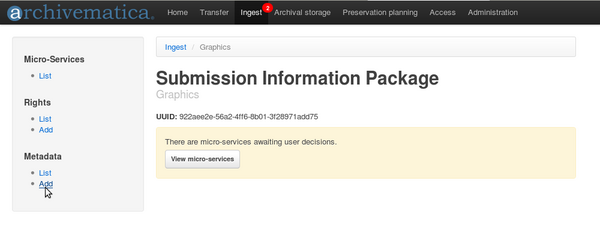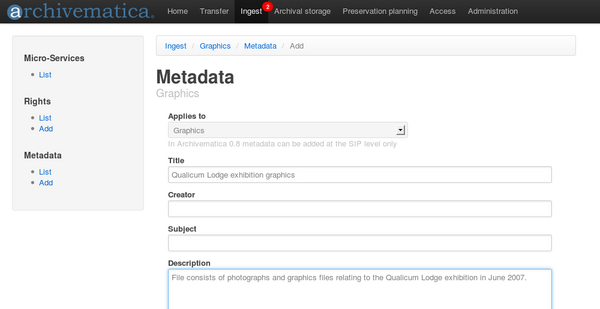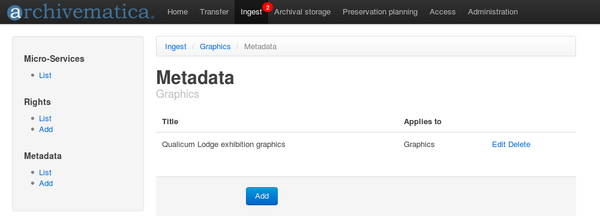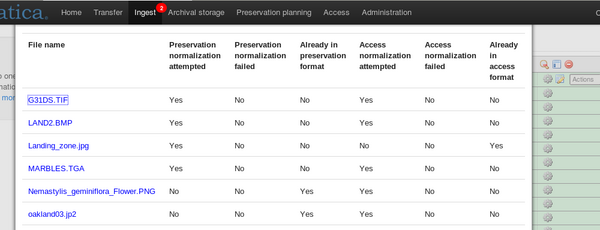UM ingest
Main Page > Documentation > User manual > User manual 0.9 > Ingest
General description
During ingest, digital objects are packaged into SIPs and run through several micro-services, including normalization, packaging into an AIP and generation of a DIP.
Should you run into an error during ingest, please see Error handling.
Create SIP
- Process transfers as described in Transfer.
- Click on the Ingest tab.
- The single SIP will move through a number of micro-services. Wait until it reaches "Normalize" and a bell icon appears (figure 2).
- To add descriptive metadata, see Add metadata, below.
- To add PREMIS rights information, see Add PREMIS, below.
- For selecting a normalization option, see Normalization, below.
Add metadata
You must add metadata prior to the normalization step. Any metadata added after normalization will not be included in the AIP package. See ICA-AtoM (Qubit) Dublin Core for information about the Dublin Core elements available. See ICA-AtoM (Qubit) Rights Entity for information about the rights elements available.
- Click on the magnifying glass icon. (figure 9).
- This will take you to the SIP detail panel. On the left-hand side, under metadata click Add (figure 10).
- Add metadata as desired (figure 11) and save it by clicking the Save button at the bottom of the screen. Note that in Archivematica 0.9 you can only add metadata at the SIP level. If you would like to add metadata to a digital object, you will need to do that once the object has been uploaded to your access system.
- When you click Save, you will see the metadata entry in the list page (figure 12). To edit it further, click Edit on the right-hand side.
- Return to the ingest tab to continue processing the SIP.
Add PREMIS
You must add PREMIS rights prior to the normalization step. Any rights added after normalization will not be included in the AIP package or the DIP upload. See ICA-AtoM (Qubit) Dublin Core for information about the PREMIS rights bases and elements available.
- Click on the magnifying glass icon. (figure 9).
- This will take you to the SIP detail panel. On the left-hand side, under rights click Add (figure 10).
- Add rights as desired (figure 11) and save it by clicking the Save button at the bottom of the screen. Note that in Archivematica 0.9 you can only add metadata at the SIP level. If you would like to add rights to a digital object, you will need to do that once the object has been uploaded to your access system. (Note that rights entries are two pages of content. To get to the second page to complete data entry, click Next) (figure...)
- When you click Save, you will see the rights entry in the list page (figure 12). To edit it further, click Edit on the right-hand side.
- Return to the ingest tab to continue processing the SIP.
Normalize
Normalizing is the process of converting ingested digital objects to preservation and/or access formats. Note that the original objects are always kept along with their normalized versions. For more information about Archivematica's preservation strategy, go to the Preservation Planning section of the manual.
- At the normalization step, the SIP will appear in the dashboard with a bell icon next to it. Select one of the normalization options from the Actions drop-down menu (figure 13):
- Normalize for preservation and access: creates preservation copies of the objects plus access copies which will be used to generate the DIP.
- Normalize for access: no preservation copies are created. Creates access copies which will be used to generate the DIP.
- Normalize for preservation: creates preservation copies. No access copies are created and no DIP will be generated.
- Do not normalize: no preservation copies are created. No access copies are created and no DIP will be generated.
- You may also Reject SIP at this stage.
- Once normalization is completed you can review the results in the normalization report. Click on the report icon next to the Actions drop-down menu (figure 14).
- The report shows what has been normalized and what is already in an acceptable preservation and access format (figure 15). For example, the file LAND2.BMP was normalized successfully to both a preservation and an access format; the file oakland03.jp2 was found to be in an acceptable preservation format already but it was necessary to generate an access copy for it.
- You may review the normalization results in a new tab by clicking on Review. If your browser has the correct plug-ins to open a file, you may open it in another tab by clicking on it. If you click on a file and your browser cannot open it, it will download locally so you can view it using the appropriate software.
- Approve normalization in the Actions drop-down menu to continue processing the SIP.
Store AIP
- After normalization is approved, the SIP is run through a number of micro-services, including processing of the submission documentation, generation of the METS file, indexing, generation of the DIP and packaging of the AIP.
- When these micro-services are complete, the user can upload DIP and store AIP.
- If desired, review the contents of the AIP in another tab by clicking on Review. More information on Archivematica's AIP structure and the METS/PREMIS file is available on the Archivematica wiki: see AIP structure and METS. You can download the AIP at this stage, as well, by clicking on it.
- From the Action dropdown menu, select "Store AIP" to move the AIP into archival storage (figure 16). You can store an AIP in any number of preconfigured directories. For instructions to configure AIP storage locations, see Administrataion manual - AIP storage locations
- From the Action drodown menu, select the AIP storage location from a pre-configured set of options.
- For information on viewing and managing stored AIPs go to Archival storage
Upload DIP
For information on uploading the DIP, go to Access.







